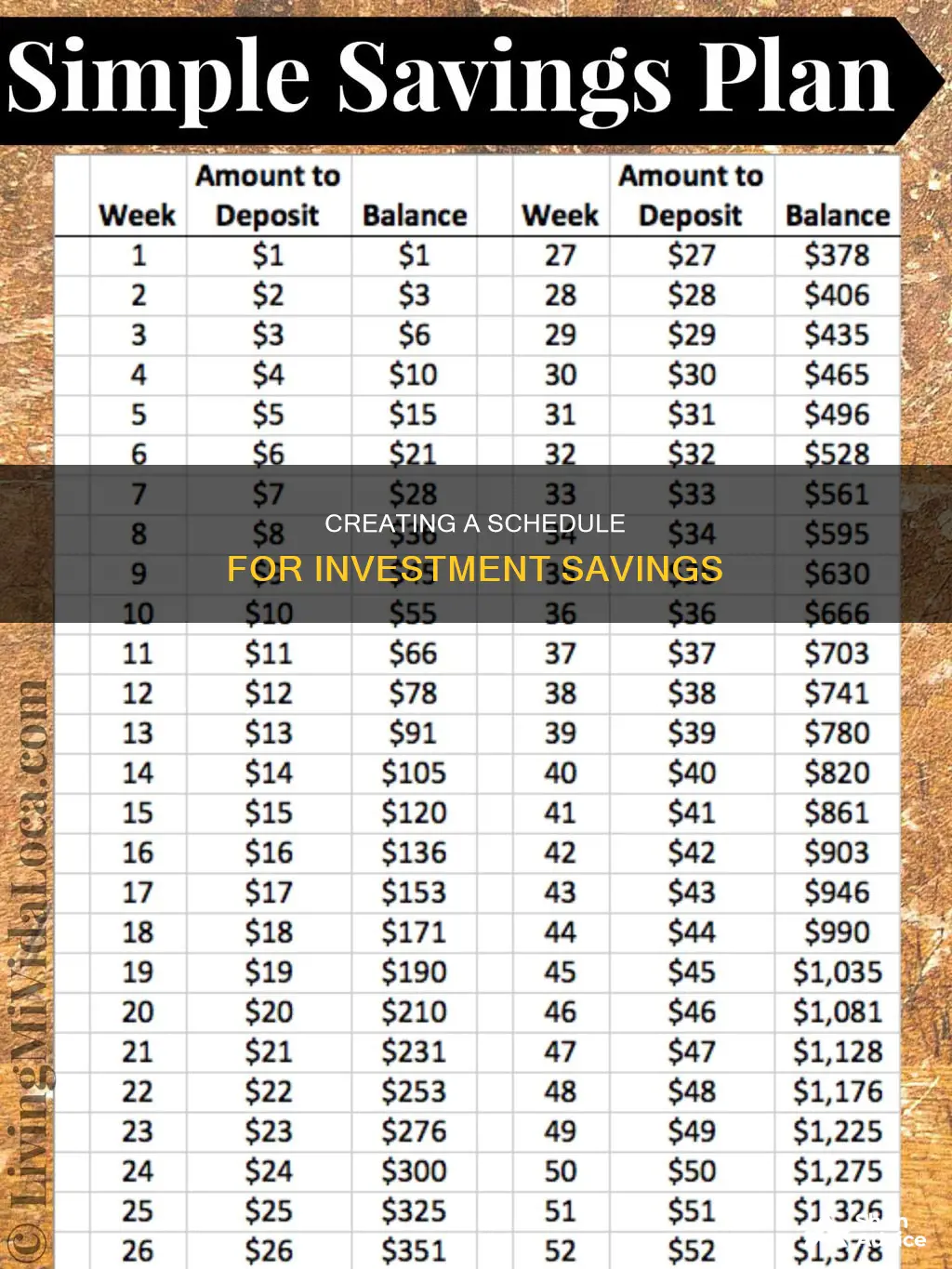
An investment-saving schedule, or IS schedule, is a macroeconomic model that illustrates the relationship between interest rates and output. It is represented by a downward-sloping graph, where the x-axis measures GDP and the y-axis measures interest rates. The IS schedule shows the equilibrium points where investment equals savings, with a lower interest rate stimulating a higher volume of investment. This, in turn, generates higher output and income through a multiplier process. The IS schedule is a useful tool for understanding how changes in market preferences can alter equilibrium levels of GDP and market interest rates.
| Characteristics | Values |
|---|---|
| Definition | A schedule that depicts the relationship between savings and the level of income |
| Purpose | To help organise thinking about macroeconomic theories and controversies |
| Components | Consumption, saving, and investment |
| Data | Interest rates, output, income, consumption, savings, investment, GDP, etc. |
| Formula | Income = Consumption + Savings |
| Graphical Representation | IS-LM graph with two curves: IS and LM |
| Variables | Liquidity, investment, and consumption |
| Limitations | Simplistic and unrealistic assumptions, cannot account for high unemployment and inflation together |
What You'll Learn
- The IS-LM model: a Keynesian macroeconomic model that shows how the market for economic goods interacts with the loanable funds market
- The I-S schedule: a schedule displaying the combinations of national income and interest rate where the equilibrium condition for the real economy holds
- The basic macroeconomic relationships: consumption, investment, and government spending
- The expected rate of return: a determinant of investment, which is found by comparing the expected economic profit to investment cost
- The equilibrium GDP: the level of output whose production will create total spending just sufficient to purchase that output

The IS-LM model: a Keynesian macroeconomic model that shows how the market for economic goods interacts with the loanable funds market
The IS-LM model, which stands for ""investment-saving" (IS) and "liquidity preference-money supply" (LM), is a Keynesian macroeconomic model that shows how the market for economic goods interacts with the loanable funds market, or money market. It is represented as a graph in which the IS and LM curves intersect to show the short-run equilibrium between interest rates and output.
The IS-LM model describes how aggregate markets for real goods and financial markets interact to balance the rate of interest and total output in the macroeconomy. The IS-LM model is a tool for looking at how the market for economic goods intersects with the loanable funds market. It depicts the short-term equilibrium point between interest rates and output, with its three variables being liquidity, investment, and consumption.
The IS-LM graph examines the relationship between output, or gross domestic product (GDP), and interest rates. The entire economy is boiled down to just two markets—output and money—and their respective supply and demand characteristics push the economy toward an equilibrium point.
The IS curve depicts the set of all levels of interest rates and output (GDP) at which total investment (I) equals total saving (S). At lower interest rates, investment is higher, which translates into more total output (GDP), so the IS curve slopes downward and to the right.
The LM curve depicts the set of all levels of income (GDP) and interest rates at which money supply equals money (liquidity) demand. The LM curve slopes upward because higher levels of income (GDP) induce increased demand to hold money balances for transactions, which requires a higher interest rate to keep money supply and liquidity demand in equilibrium.
The intersection of the IS and LM curves shows the equilibrium point of interest rates and output when money markets and the real economy are in balance. The IS-LM model serves as the conceptual foundation for the vast majority of governmental and commercial macro-econometric models.
Savings Strategies: Maximizing Output from Your Investments
You may want to see also

The I-S schedule: a schedule displaying the combinations of national income and interest rate where the equilibrium condition for the real economy holds
The I-S schedule is a tool used in macroeconomic theory to understand the relationship between income and savings. It is a graphical representation of the combinations of national income and interest rates at which the equilibrium condition holds in the real economy. The I-S schedule is derived from the consumption-income and saving-income relationships, which are fundamental components of the aggregate expenditures model.
The aggregate expenditures model is a macroeconomic theory that explains the equilibrium levels of output, income, and employment in a private and domestic economy. It considers the consumption, saving, and investment decisions of individuals and firms. The I-S schedule helps illustrate how changes in income affect savings behaviour and, consequently, the overall equilibrium in the economy.
The I-S schedule is constructed by plotting income on the horizontal axis and savings on the vertical axis. The slope of the I-S schedule represents the marginal propensity to save, indicating how much additional income will be saved rather than consumed. At lower income levels, individuals tend to consume more than their income, resulting in negative savings (dissaving). As income increases, individuals start to save a portion of their income, and at higher income levels, they save an even larger proportion. The I-S schedule captures this nonlinear relationship between income and savings.
The equilibrium condition in the real economy occurs when total investment equals total savings. The I-S schedule illustrates this by showing the combinations of national income and interest rates that satisfy this condition. The interest rate plays a crucial role in investment decisions, as it affects the expected rate of return on investments. When the interest rate is low, investment is typically higher, leading to higher total output. Therefore, the I-S schedule also captures the inverse relationship between the interest rate and investment.
The I-S schedule is a valuable tool for understanding the dynamics of income, savings, and investment in an economy. It helps economists and policymakers analyse how changes in income, interest rates, and other factors influence the equilibrium levels of output and employment. By examining the I-S schedule, they can gain insights into the behaviour of consumers and firms, making more informed decisions regarding economic policies and strategies.
Savings-Investment Spending Identity: Lessons for the Economy
You may want to see also

The basic macroeconomic relationships: consumption, investment, and government spending
An investment savings schedule is a timetable of an investment, showing the relationship between savings and the level of income.
The basic macroeconomic relationships are the components of the Keynesian Aggregate Expenditures model. In a closed economy, the components of aggregate expenditures are consumption, investment, and government spending.
Consumption and Savings
In the simplest model, people can do one of two things with their income: consume it or save it. This can be expressed as:
> Income = Consumption + Savings
Disposable income, the portion of income after taxes, is an important determinant of consumer spending. Consumption is a positive function of income, meaning that as income increases, consumption and savings increase.
The Consumption Function shows the relationship between consumption and disposable income. In this function, "a" is the intercept of the line, and "b" is the slope. "a" represents the amount of consumption when disposable income is zero, which can be positive due to borrowing or wealth transfers. "b" represents the expected increase in consumption resulting from a one-unit increase in disposable income.
The Savings Function shows the relationship between savings and disposable income and is assumed to be linear. The intercept, "e", is often negative, indicating that when disposable income is zero, savings are also negative, i.e., debt. The slope, "f", represents the Marginal Propensity to Save, or the increase in savings from any increase in disposable income.
The Marginal Propensity to Consume (MPC) is the extra amount consumed when there is an extra dollar of income. The Marginal Propensity to Save (MPS) is the extra amount saved when there is an extra dollar of income. MPC + MPS always equals 1.
Investment
Investment is the second component of aggregate expenditures and plays a significant role in the economy. It involves the creation of real capital and affects both short-run aggregate demand and long-run economic growth.
Firms invest with the profit motive, expecting a return on their investment. The real interest rate determines the level of investment, as firms will only invest when the expected rate of return is greater than the interest rate.
The Investment Demand Curve illustrates the inverse relationship between the real interest rate and the level of investment. When the real interest rate is high, fewer investment opportunities are profitable.
Non-interest rate determinants of investment include business taxes, changes in technology, and the stock of capital goods on hand. For example, tax incentives for investing in new capital or "green" investments encourage additional investment at all interest rate levels.
Government Spending
Government spending is determined by a political process and is not dependent on fundamental economic variables. It is a horizontal line in the Keynesian cross diagram, indicating that it is independent of the level of real GDP in a given year. Congressional decisions to increase or decrease government spending will shift this line up or down.
Taxes, on the other hand, typically rise or fall with economic activity. For example, income and sales taxes are based on income and sales levels, which tend to be higher during economic growth and lower during recessions.
In summary, the basic macroeconomic relationships of consumption, investment, and government spending are key components of the Keynesian Aggregate Expenditures model. These relationships help explain economic behaviour and inform policy decisions.
Kroger Savings Club: A Smart Investment Strategy
You may want to see also

The expected rate of return: a determinant of investment, which is found by comparing the expected economic profit to investment cost
An investment savings schedule is a schedule that illustrates the relationship between savings and income levels. At lower income levels, households tend to consume more than their income, whereas at higher income levels, they consume a portion of their income and save the rest.
The expected rate of return is a key determinant of investment. It is calculated by comparing the expected economic profit to the investment cost. This figure is not guaranteed but is based on historical data, which sets reasonable expectations. The formula for calculating the expected rate of return is:
> Expected Return = Σ (Return*i*) x Probability*i*)
Where *i* indicates each known return and its respective probability in the series.
For example, if an investment has a 50% chance of a 20% gain and a 50% chance of a 10% loss, the expected return would be 5% (0.5 x 0.2) + (0.5 x -0.1) = 0.05 or 5%.
The expected rate of return is influenced by the risk-free rate of return, which is often represented by the interest rate on 3-month U.S. Treasury bills. The expected return above this risk-free rate depends on the investment's beta, or its relative volatility compared to the broader market.
Calculating the expected rate of return is essential for investors as it provides an idea of probable profit versus risk. It helps investors determine whether an investment is likely to generate a positive return and if it aligns with their risk tolerance and investment goals.
Additionally, the expected rate of return is used to construct the investment demand curve, which illustrates the inverse relationship between the interest rate and the amount of investment.
In summary, the expected rate of return is a critical factor in investment decisions, providing investors with a tool to assess the potential profitability and risk of their investments.
Smart Saving and Investing Strategies for Your Kids' Future
You may want to see also

The equilibrium GDP: the level of output whose production will create total spending just sufficient to purchase that output
The equilibrium GDP is a crucial concept in economics, representing the point where the economy is in balance. In simple terms, it is the level of output where the total spending created by production is just enough to purchase that output. This equilibrium level is significant because it ensures a stable economy without excesses or shortages. Below, we delve into the components and dynamics that contribute to achieving this equilibrium.
The equilibrium GDP is determined by the interaction of consumption, investment, and income. Consumption refers to the amount of goods and services individuals purchase, while investment involves buying durable goods or assets, such as equipment or real estate. Income, in this context, is the money earned by individuals or households, also known as disposable income. The relationship between these factors is fundamental to understanding equilibrium GDP.
In a closed economy, where there is no government or foreign sector involvement, the equilibrium GDP is found when total consumption and investment equal the income or output level. This equilibrium point signifies a stable economy where supply and demand are in harmony. If total consumption and investment exceed the output, businesses will experience excess demand and adjust by increasing production. Conversely, if total consumption and investment are less than the output, businesses will have unsold inventory and will cut back on production.
The dynamics of consumption and saving play a crucial role in reaching equilibrium GDP. At lower income levels, individuals tend to consume more than their income, resulting in "dissaving" or borrowing. As income increases, consumption may still rise, but individuals also start to save a portion of their income. This relationship is illustrated by the consumption and saving functions, with the breakeven point being where income equals consumption, and savings are zero.
The investment component is guided by the profit motive, with firms investing when they expect a positive return. The real interest rate is a critical factor in investment decisions, influencing the level of investment. When the expected rate of return exceeds the real interest rate, investment increases, and vice versa. The investment demand curve demonstrates the inverse relationship between the real interest rate and the level of investment.
The equilibrium GDP is also analysed through the "leakages-injections" approach. In this context, saving is considered a "leakage" from the income stream, while investment is viewed as an "injection" into the income stream. Equilibrium is achieved when these leakages and injections balance each other out, ensuring that aggregate expenditures match the output level.
In conclusion, the equilibrium GDP represents the point where the economy is in a state of balance. It is attained when total spending from consumption and investment is sufficient to purchase the output produced. This equilibrium is influenced by factors such as income levels, consumption patterns, investment decisions, and the interplay between saving and investment. Understanding and achieving equilibrium GDP is essential for maintaining a stable and efficient economy.
Savings and Investments: Strategies for Success in Lean Times
You may want to see also
Frequently asked questions
An investment-saving schedule, or I-S schedule, is a macroeconomic model that illustrates the combinations of national income and interest rates where the equilibrium condition for the real economy (investment = savings) holds. It is represented by a downward-sloping curve, showing that a lower interest rate stimulates a higher volume of investment, which in turn generates higher output and income.
The IS-LM model, which stands for "investment-saving" and "liquidity preference-money supply," is a Keynesian macroeconomic framework that uses the I-S schedule to show how economic goods and money markets interact. The IS-LM model helps describe how changes in market preferences impact equilibrium levels of GDP and interest rates.
The IS-LM model consists of two curves: the IS curve and the LM curve. The IS curve depicts the relationship between interest rates and output, where total investment equals total savings. The LM curve illustrates the combination of income levels and interest rates where money supply equals money demand.
The I-S schedule, along with the LM schedule, helps determine the general equilibrium position for the economy as a whole. The intersection of the I-S and LM schedules shows the equilibrium point of interest rates and output when money markets and the real economy are in balance.







